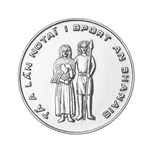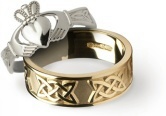Blog Categories
Blog CategoriesIrische Hochzeitstraditionen
Old Irish Wedding Traditions Still Used Today

There are many different Irish wedding traditions that take place on the day of, or around the official wedding date. They are practiced for many different reasons, including; luck, magic, superstition, wealth and fertility. These are commonly practiced and their origins have stemmed from ancient Celtic or Irish traditions, and have been practiced for many ages.
Having some of these traditions at a wedding is sure to bring the Irish spirit to any ceremony. They may be old but they are still very common today. The luck and fortune that they are supposed to bring just might work.
A Lucky Irish Horseshoe For The Bride
The horseshoe is widely known as a symbol of great luck, the same goes for the Irish. If the bride carries an iron-made horseshoe on the day of her wedding, it is said to bring a great amount of good luck to her. After the ceremony is over, the newlywed couple place the horseshoe above the doorway to their home. It is common for brides these days to carry a porcelain or horseshoe charm, instead of a traditional iron horseshoe. It's important to the bride not to hold the horse shoe in the upside-down position, as this will cause all of the luck to drain out from the horse shoe.
A Braid In The Bride's Hair
Braided hair symbolizes feminine power; it is tradition that brides wear their hair long and braided. Braids in a bride's hair not only symbolized feminine power, but also represent a great mystical beauty about them.
A Wildflower Headpiece
Often times, the braided hair was adorned with ribbons and wildflowers. Brides would wear a floral crown, picked from real wildflowers, on their wedding day. Bouquets at the wedding can also be put together entirely from wildflowers.
A Blue Wedding Dress
Blue is a symbol of purity in ancient Ireland. Brides wore blue dresses instead of the usual white. Blue was widely known as a symbol of purity, long before white was widely known as a universal symbol of virginity.
Tying The Knot
The old saying of "tying the knot" stems from a very old Irish wedding tradition. It comes from the literal action of tying the knot. A groom and bride will cross their wrists, while holding hands, and then with a ribbon, their hands are tied. The ribbon forms the symbol of infinity, wrapped around the bride and groom's wrists.
The Make-Up Bells
Ringing bells has long been thought of as a way to dispel evil and malicious spirits. This is why church bells get rung at the very end of wedding ceremonies. Irish tradition uses small bells that are customary as wedding presents to the newlyweds. These small bells are to remind them of their beautiful wedding day.
The Leap-Year Proposal
There is a tradition that can only be done on the leap day of every leap year. It allows the female to propose to the male, instead of the usual male proposing to the female. The legend goes; that a young lady was sad because the men she was interested in were always too shy to propose, so St. Patrick granted permission that all girls can propose. As long as it was on the 29th of February, on a leap year.
The Magic Handkerchief
Irish brides carried a lucky handkerchief. The handkerchief is considered to be very magical. Tradition is that it can either be sewn onto the inside of the bride's dress, carried inside her pocket or purse, or used to wrap her bouquet of flowers. After the wedding, the handkerchief is used as a christening bonnet for the first born child of the family.
The Claddagh Ring
Claddagh rings are given as engagement and wedding rings, but they could also be used as friendship rings. The ring is a symbol of love, friendship and marriage. When the heart of the ring faces out, it means that the girl is single. When the heart of the ring is facing the girl, it means that she is taken. In Ireland, the tradition is that the Claddagh ring is often handed down from mother to daughter.
 |
 |
|
| Ladies Claddagh Ring |
Gents Claddagh Ring |
Locking Of The Church Door
The locking of the church doors while in ceremony is also a common Irish wedding tradition. Although it is not particularly necessary, it is done so in case that the groom might get cold feet and decide to leave the ceremony. Once the bride and the groom are in the church, it is the guest's duty to lock the doors.
The Early Celtic Custom of The Caim
The Caim is an early Celtic custom that begins the wedding ceremony. A circle is drawn around the couple as a sign of unity with God. The circle is a symbolization of God's love. Before the couple leaves the circle, a final Caim prayer must be made.
The Ring Warming Ceremony
The ring warming ceremony is a very common tradition. In Irish wedding ceremonies, the rings are passed from guest to guest, each person gets to hold the rings. While each guests holds the rings, they either say a blessing, make a prayer or make a wish for the bride and the groom. This warming ceremony takes place before the bride and groom make their final exchange.
Wedding Day Superstitions
According to Irish tradition, depending on the day and month of the year it was, it brought different superstitions. Here is a common Bridal verse that explains all of this:
"Monday for health,
Tuesday for wealth,
Wednesday the best day of all,
Thursday for losses,
Friday for crosses,
and Saturday no day at all.”
Marry when the year is new, always loving, kind, and true.
When February birds do mate, you may wed, nor dread your fate.
If you wed when March winds blow, joy and sorrow both you'll know.
Marry in April when you can, joy for maiden and for man.
Marry in the month of May, you will surely rue the day.
Marry when June roses blow, over land and sea you'll go.
They who in July do wed, must labor always for their bread.
Whoever wed in August be, many a change are sure to see.
Marry in September's shine, your living will be rich and fine.
If in October you do marry, love will come but riches tarry.
If you wed in bleak November, only joy will come, remember.
When December's rain fall fast, marry and true love will last."
Marrying On St. Patrick's Day
It is legend that marrying on St. Patrick's Day is the luckiest of wedding dates. According to Irish tradition and belief, it is said to give the couple lifelong happiness. Many couples book their wedding days on St. Patrick's Day, so if a bride and groom happen to get their wedding date reserved on a St. Patrick's Day, they should already be considered very lucky.
Harp Music During Ceremony
Ireland's beloved musical instrument; the harp, which is our national emblem, is often played during wedding ceremonies. It is often played during the ceremony, at the wedding banquet and at all of the other wedding-related celebrations.
A Sixpence In The Bride's Left Shoe
The placement of a silver sixpence into the bride's left shoe symbolizes wealth. Not only does this silver sixpence tradition represent financial wealth, but it also brings a wealth of happiness and health for the remainder of the marriage.
The Wedding Coin

The passing of a coin between the groom and the bride is often done as a family keepsake. The newly mint coin is given from the groom to the bride while saying the words, “I give you this as a token of all I possess.” The bride will pass this coin to her oldest son, on his wedding day, who will then pass it to his bride. It gets handed down from every generation to the next.
The Month of Honey
In Irish, the word for honey is "meala". "Mi na meala", which stands for "the month of honey", is the month following the wedding ceremony. The newlyweds celebrate by drinking mead, which is a type of brew made of fermented honey. The bride and groom are given enough mead to last for a month, they are also given special goblets. This lasts for one full moon. This is where the term "honeymoon" comes from. It is understood that drinking mead is the best way to bring good beginnings to a new marriage. It is also believed that the drink helps with fertility, as well as virility, between the new couple.
